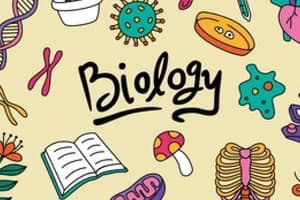Podcast
Questions and Answers
What is the primary reason why some sugars like glucose are called reducing sugars?
What is the primary reason why some sugars like glucose are called reducing sugars?
- They lack any functional groups.
- They contain complex carbohydrates.
- They have free ketone or aldehyde groups. (correct)
- They are incapable of transferring hydrogens.
Which component in Benedict's reagent provides the necessary alkaline conditions?
Which component in Benedict's reagent provides the necessary alkaline conditions?
- Sodium bicarbonate
- Sodium carbonate (correct)
- Sodium hydroxide
- Sodium chloride
What color change occurs in a positive Benedict's test?
What color change occurs in a positive Benedict's test?
- Yellow to blue
- Blue to orange red/ brick red (correct)
- Green to blue
- Blue to green
Which of the following sugars does not react with Benedict's reagent?
Which of the following sugars does not react with Benedict's reagent?
What is the role of sodium citrate in Benedict's reagent?
What is the role of sodium citrate in Benedict's reagent?
In the context of Benedict's test, which of the following is not a reducing sugar?
In the context of Benedict's test, which of the following is not a reducing sugar?
Flashcards
Reducing Sugars
Reducing Sugars
Sugars with a free ketone or aldehyde group, capable of reducing other substances.
Benedict's reagent
Benedict's reagent
A solution used to detect the presence of reducing sugars.
Sodium carbonate
Sodium carbonate
Component of Benedict's reagent, providing alkaline conditions for the test.
Positive Benedict's test
Positive Benedict's test
Signup and view all the flashcards
Non-reducing sugar
Non-reducing sugar
Signup and view all the flashcards
Sucrose
Sucrose
Signup and view all the flashcards
Sodium citrate
Sodium citrate
Signup and view all the flashcards
Benedict's test
Benedict's test
Signup and view all the flashcards
Reducing sugar
Reducing sugar
Signup and view all the flashcards
Starch
Starch
Signup and view all the flashcards
Study Notes
Benedict's Test
- Identifies reducing sugars (monosaccharides) with free ketone or aldehyde functional groups.
- Reducing sugars, like glucose, can transfer hydrogens (electrons) to other compounds, causing a reduction reaction.
Characteristics of Reducing Sugars
- All monosaccharides are reducing sugars due to their exposed carbonyl group.
- Some disaccharides, like sucrose, are non-reducing sugars and won't react with Benedict's reagent.
- Large polymers of glucose, such as starch, are not reducing sugars.
Principle of Benedict's Test
- Heating Benedict's solution with simple carbohydrates causes a color change to orange-red/brick-red.
- Copper (II) ions in the solution are reduced to Copper (I) ions, leading to the color change.
- Red copper(I) oxide formed is insoluble in water and precipitates out of solution, forming a precipitate.
Benedict Reagent
- Sodium carbonate provides alkaline conditions necessary for the redox reaction.
- Sodium citrate complexes with copper (II) ions to prevent deterioration to copper(I) ions during storage.
Objective and Specificity
- The objective of Benedict's test is to distinguish between reducing and non-reducing sugars.
- Benedict's test is specific for reducing sugars.
Studying That Suits You
Use AI to generate personalized quizzes and flashcards to suit your learning preferences.
Description
Identify reducing sugars with Benedicts reagent. Learn about monosaccharides, reduction reactions and color changes.





